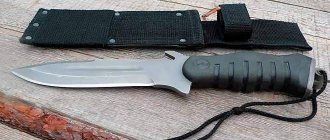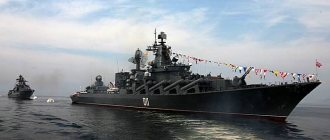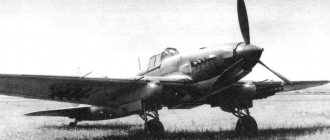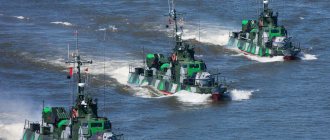Goals and objectives of the Russian Navy
Currently, the Government of the Russian Federation has assigned the following tasks to the Navy:
deterrence from the use of military force or the threat of its use against Russia; protection by military methods of the country’s sovereignty, extending beyond its land territory to internal sea waters and the territorial sea, sovereign rights in the exclusive economic zone and on the continental shelf, as well as freedom of the high seas; creating and maintaining conditions to ensure the safety of maritime economic activities in the World Ocean; ensuring Russia's naval presence in the World Ocean, demonstration of the flag and military force, visits of ships and naval vessels; ensuring participation in military, peacekeeping and humanitarian actions carried out by the world community that meet the interests of the state.
Caspian flotilla: composition, weapons
The Caspian Sea is an inland body of water that during the Soviet period washed the shores of two countries - Iran and the USSR. After 1991, several independent states appeared in this region, and the situation became seriously complicated.
The international treaty between Azerbaijan, Iran, Kazakhstan, Russia and Turkmenistan, signed on August 12, 2022, defines the Caspian Sea as a zone free from NATO influence.
The Caspian Flotilla of the Russian Federation includes:
- patrol ships of the near sea zone of the Gepard project
- (2 pieces);
- eight small ships of different designs;
- landing craft;
- artillery and anti-sabotage boats;
- minesweepers.
Structure and combat strength of the Russian Navy
The Russian Navy includes the following associations: 4 fleets - the Baltic Fleet, the Black Sea Fleet, the Northern Fleet and the Pacific Fleet, as well as the Caspian Flotilla.
The Navy includes the following forces:
1. Coastal forces 2. Surface forces 3. Submarine forces 4. Naval aviation
The Navy also includes units and formations of OSNAZ ships subordinate to the Main Directorate of the General Staff of the Russian Armed Forces, ships of the Hydrographic Service subordinate to the Directorate of Navigation and Oceanography of the Russian Ministry of Defense, ships of the Search and Rescue Directorate and the Auxiliary Fleet of the Russian Navy, as well as special-purpose formations (SpN), combat and logistical support for the coastal service of the fleet.
Surface forces are used for:
protection of sea communications; transportation and cover of landings; laying minefields and combating mine danger; ensuring the exit and deployment of submarine forces, their return to bases.
Submarine forces are used to launch surprise attacks on maritime and continental targets and for reconnaissance purposes.
Naval aviation is intended for:
confrontation with groups of surface ships in the ocean; bombing and missile attacks on enemy coastal targets; repelling attacks by enemy aircraft and anti-ship missiles; target designation of missile weapons of ships during the destruction of submarines.
Tasks of the coastal fleet forces:
coastal defense (naval bases, ports, bases and coastal facilities); conducting combat operations as part of sea, air and airborne assault forces.
Submarine fleet:
The basis of the Navy's submarine forces are nuclear submarines (NPS) armed with ballistic and cruise missiles (SSBNs, PLATs, SSGNs, MPLATRKs and special purpose missiles); also diesel-electric.
Partners
Authors of the portal
- Commander of “K-43” A.I. Terenov
- Alexander Chebotarev, captain 2nd rank, served on the BOD "Kerch", MPK-073, "Flag of the Motherland", permanent correspondent of "Red Star" on the Caspian Flotilla
- Alexander Usovsky
- Sergey Siry, Chairman of the military-historical section of the House of Scientists of the Russian Academy of Sciences, chairman of the section of the history of the Russian Navy, historiographer of the St. Petersburg Maritime Assembly, honored worker of higher education of the Russian Federation, professor
- Boris Ivanovich Marchenko, Professor of the Department of Missile and Artillery Weapon Systems of the Navy, Naval Academy named after. N.G. Kuznetsova, retired captain 1st rank, Doctor of Technical Sciences, Professor, Honorary Worker of Science and Technology of the Russian Federation
- Yuri Varganov, Candidate of Historical Sciences, Associate Professor, Honored Worker of Culture of the Russian Federation, Captain 1st Rank
- Mikhail Bogachev, retired captain 1st rank, Nakhimov graduate of 1968, couturier, author of many stories
- Evgeniy Alekseev, a graduate of the Vyborg Navy Jung School, author of the novel in verse “Women”, “Atlantis”, “Shadows by the Fireplace”, etc.
- Igor Aleksandrovich Smirnov, retired captain 1st rank, Doctor of Science, professor, author of the books “Lieutenant’s Voyage”, “Voices of Veterans”, “Bureaucracy and We”
- Viktor Fedorov, poet, performer - multiple winner of All-Union, All-Russian and international festivals, rallies and art song competitions, diploma winner of the XII World Festival of Youth and Students in Moscow. Since March 1999 - member of the St. Petersburg branch of the Union of Writers of Russia. Since 1972 - member of the St. Petersburg KSP "Meridian". Member of the jury of song festivals
- Mikhail Tretyak, captain 1st rank reserve, candidate of naval sciences, poet, performer
- Valentin Mitrofanov, publisher, editor, candidate of sciences, associate professor, author of the book “Commander. Commodore. Captain"
- Mikhail Irinin
- Valery Valkov, candidate of military sciences, associate professor
- Igor Kozyr, captain 1st rank reserve, candidate of technical sciences, senior researcher, member of the presidium of the Polar Convoy ROO, press secretary of the Maritime Literary and Art Foundation named after. Viktor Konetsky
- Timur Gainutdinov, captain 2nd rank, head of the department of coverage of combat training and educational work of the Pacific Fleet newspaper "Combat Watch"
- Milena Sigaeva, journalist
Formations of the Special Forces of the Navy
Special forces units for combating underwater sabotage forces and means:
102nd special forces squad to combat PDSS, military unit 27203 (Sevastopol) 136th special forces squad to combat PDSS, military unit 75976 (Novorossiysk) 101st special forces squad to combat PDSS (Petropavlovsk-Kamchatsky) 137th special forces squad to combat PDSS, military unit 72969 (Makhachkala) 159th special forces squad to combat PDSS, military unit 87200 (Razboynik Bay) 311th special forces squad to combat PDSS, military unit 59048 (Petropavlovsk-Kamchatsky) 313th special purpose detachment to combat PDSS, military unit 10742 (Baltiysk) 473rd special purpose detachment to combat PDSS, military unit 39080 (Kronstadt) 152nd special forces squad to combat PDSS, military unit 13106 (Polyarny) 140th special forces squad to combat PDSS, military unit 69068 (Vidyaevo) 160th special forces squad to combat PDSS, military unit 09619 (Murmansk) 269th special purpose detachment to combat PDSS, military unit 30853 (Gadzhievo village) 153rd special purpose detachment to combat PDSS (Gremikha)
Development strategy of the Russian Navy
One of the most important tasks in the development of the Russian Navy is the formation of multi-purpose general purpose naval groups capable of reliably fending off military threats from sea directions, ensuring the reliability of transport communications and the protection of merchant ships, and effectively combating piracy. The Navy will increasingly focus on a region such as the Arctic, where the richest bioresources, hydrocarbon reserves and other minerals are concentrated. As a result, the Navy will receive ships that will be able to solve problems in the Arctic zone for a long time. They will have a nuclear power plant and have a certain ice class.
The development of the naval personnel of general-purpose naval forces at the stage of 2012-2020 should be aimed at creating a grouping of forces of the SNS, increasing the combat potential of submarine forces, increasing the composition and combat capabilities of surface forces, and creating maritime rapid response forces. After 2022, we can predict a transition to large-scale construction of autonomous uninhabited underwater vehicles and marine robotic systems, the development of special bottom equipment, deployed mainly from underwater carriers, of various types and purposes.
At the second stage of development, from 2022 to 2030, it is expected to complete the creation and put into service weapons based on new physical principles, to create promising models of weapons for general purpose naval forces of the next generation.
Principles
Patriotism - the project is designed to develop a sense of patriotism, pride in the heroism of our ancestors, by publishing information about the glorious victories of military sailors.
Independence - the project is non-departmental, not giving preference to any state, private or public structure, but working closely with all.
Encyclopedic - the project provides a wide range of information in specialized sections.
Democratic - the project is open to everyone who is interested in naval topics; it reflects the diversity of opinions and views on a particular topic. At the same time, the project is not a platform for political or other harsh discussions due to its informational focus.
Openness - all data presented in the project is taken only from open sources and does not contain information that is not subject to disclosure. Links to the source/author are required.
Interestingness is achieved by completeness and periodic updating of information, ease of use, colorfulness and accessibility of the posted materials.
Plan
As part of the GPV-2020, it is planned to place orders for: up to ten strategic missile submarines of Project 955/955A/955U and the same number of multi-purpose nuclear submarines of Project 855/855M, twenty diesel and non-nuclear submarines, six will be Project 636.3 Varshavyanka submarines. , and fourteen boats of the modified project 677 Lada, four Mistral helicopter carriers, eight frigates of project 22350, six frigates of project 11356, thirty-five corvettes, of which at least twenty corvettes of projects 20380 and 20385, and corvettes of a completely new project, from five up to ten small missile ships of Project 21631, six large landing ships of Project 11711, at least ten small landing ships on the air cavity of Project 21820 "Dugong", a series of basic minesweepers of Project 12700 "Alexandrite".
The design of a new destroyer with a nuclear power plant is also being completed. Based on the promising project, it is planned to build 6 ships. The destroyers will have elements of anti-missile and anti-space defense. The Russian Navy should receive 14-16 newest destroyers within 15-20 years.
In addition, ships for the Arctic coastal zone are being developed for the Navy to patrol the Barents Sea, and in the future the Kara Sea, which are capable of solving the problems of maintaining a favorable operational regime and ensuring the safety of maritime economic activity. First of all, such ships will be needed to ensure the safety and functioning of oil and gas production platforms on the shelf. The state armament program provides for such ships, including the creation of support vessels.
Small surface combat ships and boats
Small rocket ships
Small rocket ship "Mirage"Small rocket ship "Shtil"Small rocket ship "Geyser"Small rocket ship "Zyb"Small rocket ship "Liven"Small rocket ship "Iney"Small rocket ship "Moroz"Small rocket ship "Razliv"Small rocket ship ship "Rassvet"Small rocket ship "Smerch"Small rocket ship "Passat"
Project 21631
Small rocket ship "Grad Sviyazhsk" Small rocket ship "Uglich" Small rocket ship "Veliky Ustyug" Small rocket ship "Green Dol" Small rocket ship "Serpukhov" Small rocket ship "Vyshny Volochek" Small rocket ship "Orekhovo-Zuevo" Small rocket ship ship "Ingushetia"
Project 22800
Small rocket ship "Mytishchi" (formerly "Uragan")Small rocket ship "Sovetsk"Small rocket ship "Odintsovo"Small rocket ship "Kozelsk"
Missile boats
Project 12411
"Zarechny" "Morshansk" R-47 "Dimitrovgrad" R-2 "Chuvashia" R-60R-109R-239 "Naberezhnye Chelny" R-160R-261R-297R-298R-11R-14R-18R-19R-20R-24R -29″Ivanovets”
"Karachay-Cherkessia" "Borovsk" "Budennovsk"
Small anti-submarine ships
Small anti-submarine ship MPK-134 "Muromets" Small anti-submarine ship MPK-118 "Suzdalets" Small anti-submarine ship MPK-199 "Kasimov" Small anti-submarine ship MPK-207 "Povorino" Small anti-submarine ship MPK-217 "Yeysk" Small anti-submarine ship MPK " Ust-Ilimsk"Small anti-submarine ship MPK-64 "Metel"Small anti-submarine ship MPK-221Small anti-submarine ship MPK-222 "Koreets"Small anti-submarine ship MPK-125 "Sovetskaya Gavan"Small anti-submarine ship MPK-82Small anti-submarine ship MPK-107Small anti-submarine ship MPK-14 "Monchegorsk" Small anti-submarine ship MPK-59 "Snezhnogorsk" Small anti-submarine ship MPK-194 "Brest" Small anti-submarine ship MPK-203 "Yunga" Small anti-submarine ship MPK-7 "Onega" Small anti-submarine ship MPK-130 "Naryan" -Mar"
Project 1331M
Small anti-submarine ship MPK-105 Small anti-submarine ship MPK-224 "Aleksin" Small anti-submarine ship "Kabardino-Balkaria" (formerly MPK-227) Small anti-submarine ship MPK-228 "Bashkortostan" Small anti-submarine ship MPK-229 "Kalmykia" Small anti-submarine ship MPK-99 "Zelenodolsk"Small anti-submarine ship MPK-192 "Urengoy"Small anti-submarine ship MPK-205 "Kazanets"
Small anti-submarine ship MPK-220 "Vladimirets"
Small artillery ships
Project 21630
Small artillery ship "Astrakhan"Small artillery ship "Volgodonsk"Small artillery ship "Makhachkala"
Project 1204
AK-223AK-248AK-201AK-209
Raptor-class patrol boats










